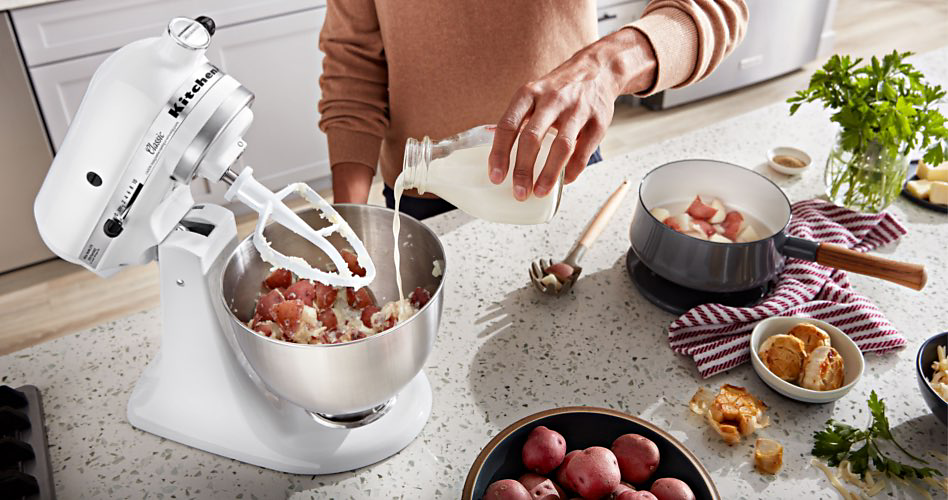
One of the most versatile and popular small kitchen appliances nowadays is the stand mixer. But the act of mixing ingredients wasn’t always done with such ease. Like with other technological marvels for the kitchen (and otherwise), this modern convenience is something our ancestors did not have. When it came to mixing dough for homemade cookies, whipping cream, or making bread, this was all done by hand.
Through history, people have used various types of tools to mix ingredients together. Eventually, these tools included electrical components that offered some assistance to the otherwise fully manual task. But electric mixers have actually only been around for about a century. And the road to get to these countertop small appliances was quite an interesting one.
Mixers in the 19th century

We’re all familiar with the whisk, a handheld kitchen gadget with wires that circulates air nicely within ingredients as you stir. But even that is a fairly modern convenience.
Before the wire whisk was invented circa 1841, bakers used a grouping of twigs from apple or peach trees as a makeshift, handheld mixing device. Interestingly, this wasn’t necessarily to make the mixing process easier: it was more so to integrate the fragrance of the wood into the batter. Mixing itself was a handheld job, literally: two hands rolled around in the ingredients to mix them together. Naturally, there were limitations to this.
The invention of the wire whisk and “egg beater”
The wire whisk was invented in France in the mid-19th century. It eventually made its way to bakers everywhere, helping ease the burden of the sometimes arduous mixing process. The wire whisk still exists today, commonly found in stores and kitchens everywhere. It comes in handy for light mixing jobs, like omelettes, pancake batter, and fried fish batter; or for those who are happy to do things the “old-school” way.
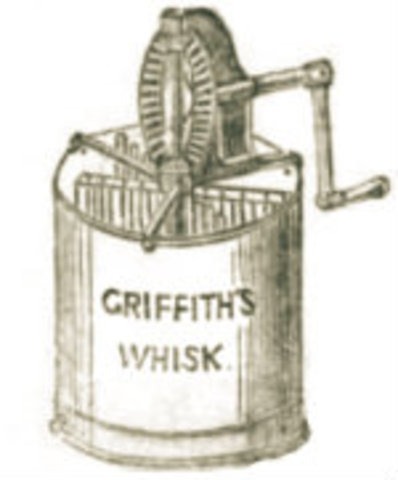
From there, many inventors sought out to find a way to make the mixing process even more efficient. The logical solution was to add some form of mechanism to the standard whisk. The invention of the first mechanized mixer is credited to a tinsmith from Baltimore, Maryland named Ralph Collier. In 1856, he developed an “egg beater” device with parts that rotated. The gear mechanism in the “egg beater,” it’s worth noting, ended up sparking innovation in a number of other categories, from drills to car transmissions.
A year later, British inventor E.P. Griffith introduced his version of the “egg beater.” Instead of needing to be held by hand, it could be positioned inside the pot. This was followed two years later in 1859 when J.F. and E.P. Monroe patented a hand-turned rotary mixer. It was eventually sold to Dover Stamping Company and became a major success. Oddly, it was marketed as being for both food and mixing paint, though it’s unlikely anyone today would consider using the same device for both (and questionable whether anyone did back then either.) Nonetheless, the intent was clear: this device was more powerful than anything that had been seen before in the category.
As with any revolutionary product, competitors came out in droves with their own versions of the egg beater device with a crank on the side. In 1885, it is believed that Rufus Eastman designed the first mixer with an electric motor, which was marketed as being for cream, eggs, and liquor.
This was the first indication that the concept of mixing with a machine could be done and afford greater efficiencies in the kitchen. So, it’s no surprise that innovation continued.
Mixers in the early 20th century
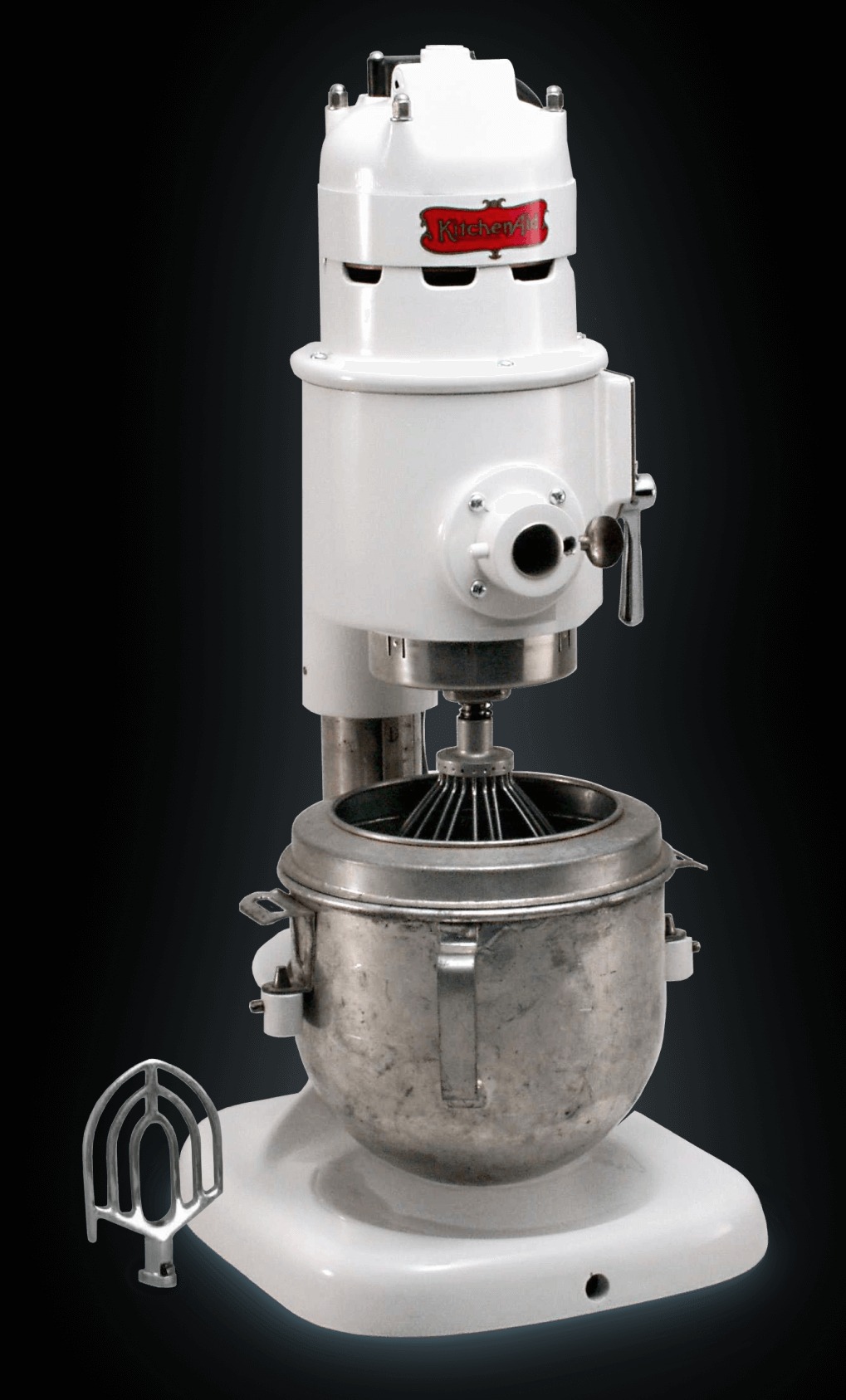
Onto the next century, inventors and businesses were still trying to come up with a way to simplify the mixing process. In 1908, Herbert Johnson, an engineer for Hobart Manufacturing Company, was inspired to create a mechanical mixer when he noticed a baker tirelessly mixing dough with a spoon. He was mixing so vigorously that he was dripping perspiration into the ingredients.
Building on the electric eggbeater, Johnson developed a mixer that used planetary action, moving the bowl in a circular fashion one way while the mixer rotated the opposite way. It was genius! The machine, called the Model H, had a massive 80-quart capacity and was used in commercial bakeries on U.S. Navy vessels. But Johnson had still not developed a version that could be used in the traditional household. While this information cannot be substantiated, rumours suggest that a wife of a Hobart company executive was using a test model in her kitchen and called it “the best kitchen aid I’ve ever had.” Sound familiar?
The birth of KitchenAid
The KitchenAid branded Food Preparer, which is an early version of what we know as a stand mixer today, made its debut for everyday homes in 1919. It had a 5-quart capacity, weighed a whopping 65 lbs., and was marketed specifically for making bread. Its price of $189 sounds reasonable, but based on inflation, this would equate to about $3,000 today.
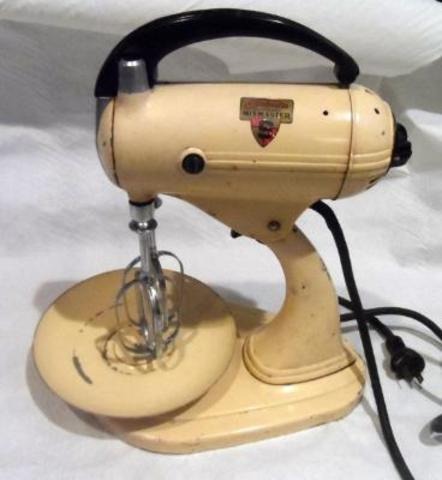
Due to the high price, Hobart felt women doing door-to-door sales was the only way to convince retailers that it was worth the price of entry and get customers (at least those who could afford one) interested. The machines looked similar to the mixers we know today but with speeds indicated by function, like Beat-Whip instead of numbers from 1-10 like are found on mixers today.
It’s worth noting that attachments for a mixer aren’t new: these traveling saleswomen also showcased attachments for doing everything from juicing citrus fruits to grinding food. These were far more rudimentary compared to the attachments that exist today, but were evidence that Hobart was onto something big. Naturally, the women they visited were blown away. Seeing all the attention KitchenAid was getting, Sunbeam entered the scene in 1930 with its much more affordable MixMaster, which sold for about $19, or $338 in today’s currency.
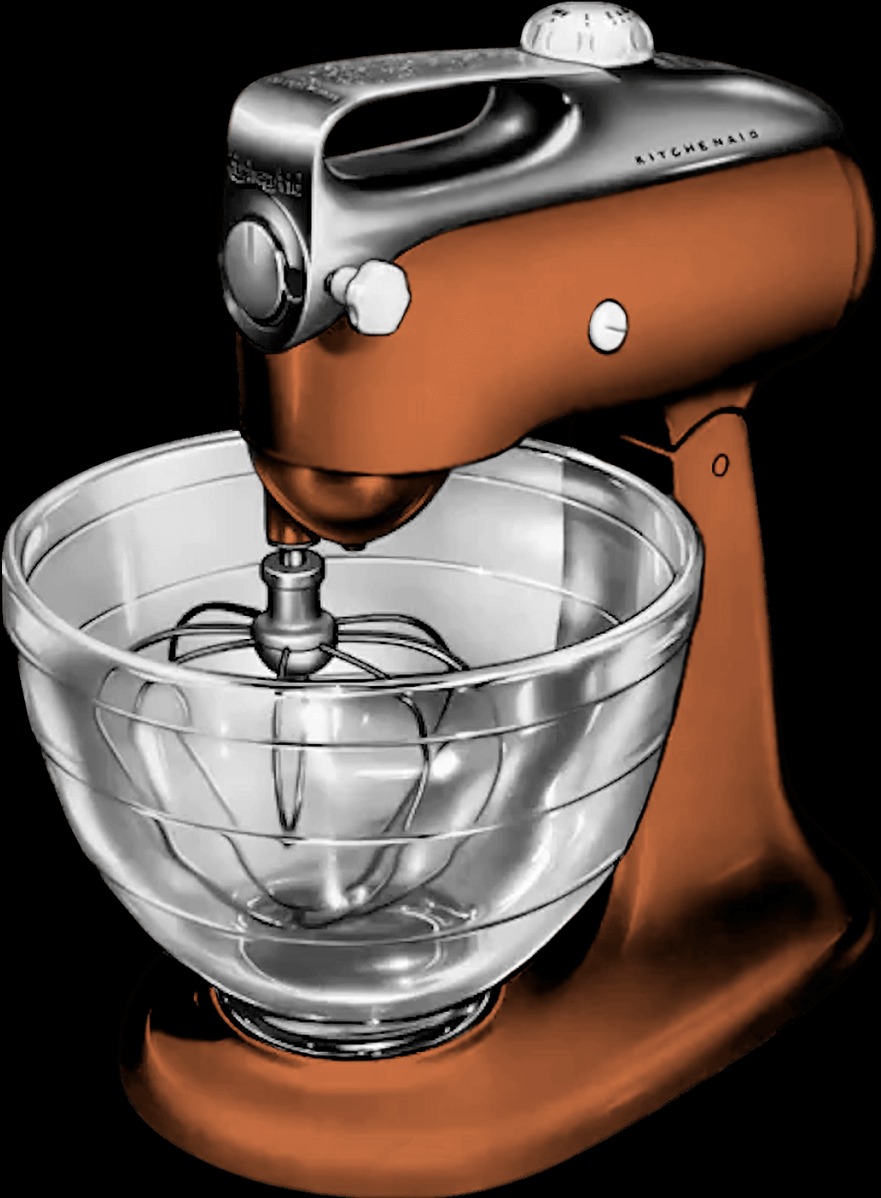
In 1936, after working with industrial designer and former Vanity Fair art editor Egmont Arens, KitchenAid refined the look of its machine, patented the bullet-shaped design that remains the signature look today, and cut the price of the Model H down to just $55 or the equivalent of about $970 today. By 1955, the KitchenAid mixer was being offered in trendy colours to make them appear more stylish for the home, like Petal Pink, Sunny Yellow, Satin Chrome, and Island Green.
Mixers in the late 20th to early 21st century
In the 1960s, the stand mixer category was joined by the electric hand mixer. Sunbeam filed a patent for one in 1953, which was granted in 1961. In 1964, Dynamic introduced its model. The hand mixer combined the best of both worlds: it was small and handheld so it didn’t take up a lot of room, but it also offered the power of electricity to move the two beaters around in a circular motion so you didn’t have to use manual effort. Electric handheld mixers aren’t as powerful as stand mixers and can’t handle denser dough. But they represent another important innovation in the category.

KitchenAid and Sunbeam remained the leader in the stand mixer category for some time. But by the 1970s, the Cuisinart food processor was launched by Carl Sontheimer and it became a hit. His partnerships with acclaimed culinary names like James Beard, Julia Child, and Helen McCully helped solidify Cuisinart’s position in the market. By 1977, Cuisinart was selling hundreds of machines every month.
By then, however, several other brands had joined the fray as well, some of which remain today, like GE, Breville, and and Hamilton Beach, and others that have since fallen by the wayside
Mixers in the 21st century
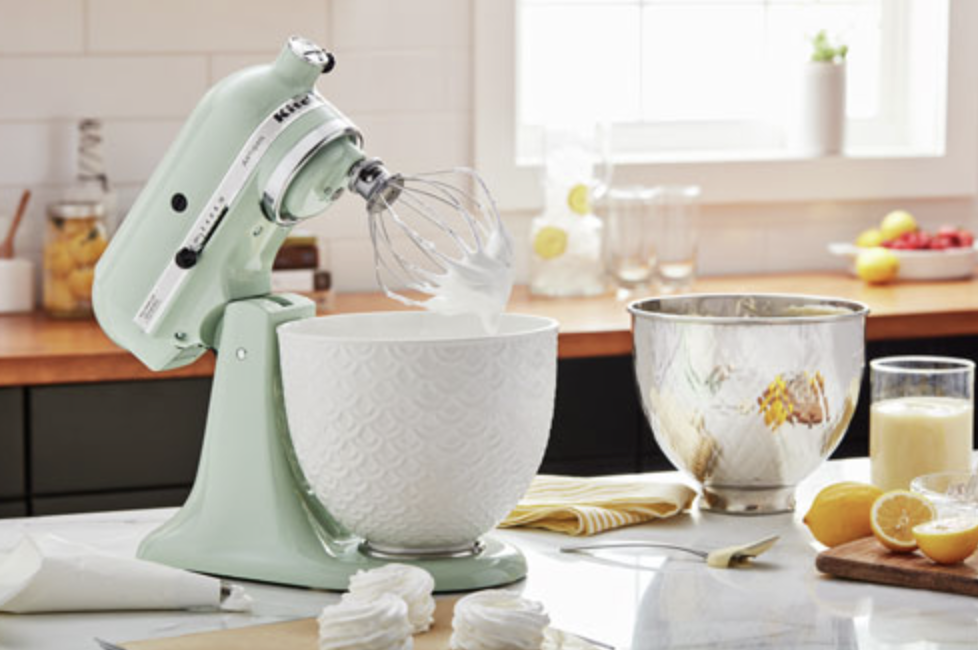
Today, stand mixers are a staple in every kitchen. KitchenAid remains an innovator but other popular brands like Cuisinart, Hamilton Beach, GE, Costway, Frigidaire, Whirlpool, Wolf Gourmet, and Kenmore, have their own versions, too.
Today’s stand mixers are more powerful, come with features like tilt-head designs, and accessories to do everything from make homemade ice cream to grind meat and spiralize vegetables. They are lightweight, sleek, and stylish, and the colour options are abundant.
Stand mixers are even starting to integrate smart technology. At CES 2023, GE introduced its GE Profile Smart Mixer with Auto Sense that has a built-in scale, timer, and easy-click attachment system. Auto Sense technology measures changes in texture and viscosity to optimize mixing so you don’t have to worry about over- or under-mixing. It aims to make the process even more effortless.
KitchenAid continues to innovate, too, with the newest version of the Artisan stand mixer, introduced in late 2022, that offers improvements like a new pour shield to prevent spills when you’re adding ingredients during a mix, and a new pastry beater attachment included in the bundle. And, of course, a long list of vibrant and exciting colours.
Mixing has come a long way

Over the last two-plus centuries, mixing ingredients in the kitchen has come a long way. We might take for granted how simple it is to pour ingredients into a bowl, plug the machine in, select a speed, and switch it to the “on” position, then walk away to tend to other tasks.
Not only are stand mixers more convenient, they also help us save time. If you have ever tried to knead dough manually for bread, you know how much strength and endurance is needed, not to mention time. What’s more, people who adore baking but suffer from muscle-related issues, conditions like arthritis, or other ailments that make manual mixing out of the question can continue to enjoy a past-time they love thanks to stand mixers.
Sure, it’s still nice to mix things by hand every now and then. There’s just something about the oils from your skin mixing in with dough that imparts a consistency, flavour, and “cooking with love” feeling. But it’s nice to have the choice to do this only for certain recipes, and from time to time, versus having no other option.

It’s amazing to think of how far we’ve come from a bunch of twigs bundled together to sleek and stylish bullet-shaped stand mixers that can not only mix with great power and efficiency, but also do more than we ever could have imagined.
Check out a wide selection of the latest and greatest stand mixers at Best Buy online.



